Recent Progresses on Hybrid Lithium Niobate External Cavity Semiconductor Lasers
Abstract
1. Introduction
2. Hybrid ECSLs Integrated with Different TFLN Photonic Structures
2.1. ECSLs Intergrated with TFLN Microrings
2.2. ECSL Integrated with TFLN Loop Mirror and DBR
2.3. ECSL Integrated with Compound TFLN PICs
3. Conclusions and Future Perspective
Author Contributions
Funding
Institutional Review Board Statement
Informed Consent Statement
Data Availability Statement
Conflicts of Interest
Abbreviations
| DBR | distributed Bragg reflector |
| DC | directional coupler |
| DFB | distributed-feedback |
| EBL | electron beam lithography |
| ECDL | external cavity diode laser |
| ECSL | external cavity semiconductor laser |
| EO | electro-optic |
| FP | Fabry–Pérot |
| FWHM | full width at half maximum |
| GSG | ground–signal–ground |
| LD | laser diode |
| LM | loop mirror |
| LiDAR | light detection and ranging |
| MLL | mode-locked laser |
| MRR | micro-ring resonator |
| MZI | Mach–Zehnder interferometer |
| MZM | Mach–Zehnder modulator |
| PIC | photonic integrated circuit |
| PLACE | photolithography-assisted chemo-mechanical etching |
| PM | phase modulator |
| PS | phase shifter |
| PPLN | periodically poled lithium niobate |
| REI | rare-earth ion |
| RF | radio frequency |
| RSOA | reflective semiconductor optical amplifier |
| SAF | single-angled facet |
| SEM | scanning electron microscope |
| SHG | second-harmonic generation |
| SLR | Sagnac loop reflector |
| SMSR | side mode suppression ratio |
| SSC | spot size converter |
| SOA | semiconductor optical amplifier |
| TFLN | thin film lithium niobate |
| TO | thermo-optic |
| UV | ultraviolet |
References
- Margalit, N.; Xiang, C.; Bowers, S.M.; Bjorlin, A.; Blum, R.; Bowers, J.E. Perspective on the future of silicon photonics and electronics. Appl. Phys. Lett. 2021, 118, 220501. [Google Scholar] [CrossRef]
- Bie, Y.-Q.; Grosso, G.; Heuck, M.; Furchi, M.M.; Cao, Y.; Zheng, J.; Bunandar, D.; Navarro-Moratalla, E.; Zhou, L.; Efetov, D.K.; et al. A MoTe2-based light-emitting diode and photodetector for silicon photonic integrated circuits. Nat. Nanotechnol. 2017, 12, 1124–1129. [Google Scholar] [CrossRef] [PubMed]
- Nagarajan, R.; Joyner, C.H.; Schneider, R.P.; Bostak, J.S.; Butrie, T.; Dentai, A.G.; Dominic, V.G.; Evans, P.W.; Kato, M.; Kauffman, M.; et al. Large-scale photonic integrated circuits. IEEE J. Sel. Top. Quant. 2005, 11, 50–65. [Google Scholar] [CrossRef]
- Kikuchi, K. Fundamentals of Coherent Optical Fiber Communications. J. Light. Technol. 2016, 34, 157–179. [Google Scholar] [CrossRef]
- Del’Haye, P.; Schliesser, A.; Arcizet, O.; Wilken, T.; Holzwarth, R.; Kippenberg, T.J. Optical frequency comb generation from a monolithic microresonator. Nature 2007, 450, 1214–1217. [Google Scholar] [CrossRef] [PubMed]
- Schliesser, A.; Picqué, N.; Hänsch, T.W. Mid-infrared frequency combs. Nat. Photon. 2012, 6, 440–449. [Google Scholar] [CrossRef]
- Li, X.; Shi, J.; Wei, L.; Ding, K.; Ma, Y.; Sun, K.; Li, Z.; Qu, Y.; Li, L.; Qiao, Z.; et al. Research Progress of Wide Tunable Bragg Grating External Cavity Semiconductor Lasers. Materials 2022, 15, 8256. [Google Scholar] [CrossRef] [PubMed]
- Newman, Z.L.; Maurice, V.; Drake, T.; Stone, J.R.; Briles, T.C.; Spencer, D.T.; Fredrick, C.; Li, Q.; Westly, D.; Ilic, B.R.; et al. Architecture for the photonic integration of an optical atomic clock. Optica 2019, 6, 680–685. [Google Scholar] [CrossRef]
- Marin-Palomo, P.; Kemal, J.N.; Karpov, M.; Kordts, A.; Pfeifle, J.; Pfeiffer, M.H.P.; Trocha, P.; Wolf, S.; Brasch, V.; Anderson, M.H.; et al. Microresonator-based solitons for massively parallel coherent optical communications. Nature 2017, 546, 274–279. [Google Scholar] [CrossRef] [PubMed]
- Poulton, C.V.; Yaacobi, A.; Cole, D.B.; Byrd, M.J.; Raval, M.; Vermeulen, D.; Watts, M.R. Coherent solid-state LIDAR with silicon photonic optical phased arrays. Opt. Lett. 2017, 42, 4091–4094. [Google Scholar] [CrossRef]
- Su, Q.; Wei, F.; Sun, G.; Li, S.; Wu, R.; Pi, H.; Chen, D.; Yang, F.; Ying, K.; Qu, R.; et al. Frequency-Stabilized External Cavity Diode Laser at 1572 nm Based on Frequency Stability Transfer. IEEE Photonics Technol. Lett. 2022, 34, 203–206. [Google Scholar] [CrossRef]
- Lang, X.; Jia, P.; Chen, Y.; Qin, L.; Liang, L.; Chen, C.; Wang, Y.; Shan, X.; Ning, Y.; Wang, L. Advances in narrow linewidth diode lasers. Sci. China Inf. Sci. 2019, 62, 61401. [Google Scholar] [CrossRef]
- Bai, Z.; Zhao, Z.; Tian, M.; Jin, D.; Pang, Y.; Li, S.; Yan, X.; Wang, Y.; Lu, Z. A comprehensive review on the development and applications of narrow-linewidth lasers. Microw. Opt. Technol. Lett. 2022, 64, 2244–2255. [Google Scholar] [CrossRef]
- Liang, W.; Ilchenko, V.S.; Eliyahu, D.; Savchenkov, A.A.; Matsko, A.B.; Seidel, D.; Maleki, L. Ultralow noise miniature external cavity semiconductor laser. Nat. Commun. 2015, 6, 7371. [Google Scholar] [CrossRef] [PubMed]
- Virtanen, H.; Uusitalo, T.; Karjalainen, M.; Ranta, S.; Viheriälä, J.; Dumitrescu, M. Narrow-Linewidth 780-nm DFB Lasers Fabricated Using Nanoimprint Lithography. IEEE Photonics Technol. Lett. 2018, 30, 51–54. [Google Scholar] [CrossRef]
- Spiessberger, S.; Schiemangk, M.; Wicht, A.; Wenzel, H.; Brox, O.; Erbert, G. Narrow Linewidth DFB Lasers Emitting Near a Wavelength of 1064 nm. J. Light. Technol. 2010, 28, 2611–2616. [Google Scholar] [CrossRef]
- Spießberger, S.; Schiemangk, M.; Wicht, A.; Wenzel, H.; Erbert, G.; Tränkle, G. DBR laser diodes emitting near 1064 nm with a narrow intrinsic linewidth of 2 kHz. Appl. Phys. B 2011, 104, 813–818. [Google Scholar] [CrossRef]
- Laue, C.K.; Knappe, R.; Boller, K.-J.; Wallenstein, R. Wavelength tuning and spectral properties of distributed feedback diode lasers with a short external optical cavity. Appl. Opt. 2001, 40, 3051–3059. [Google Scholar] [CrossRef]
- Signoret, P.; Myara, M.; Tourrenc, J.P.; Orsal, B.; Monier, M.H.; Jacquet, J.; Leboudec, P.; Marin, F. Bragg section effects on linewidth and lineshape in 1.55-μm DBR tunable laser diodes. IEEE Photonics Technol. Lett. 2004, 16, 1429–1431. [Google Scholar] [CrossRef]
- Chen, J.; Chen, C.; Guo, Q.; Sun, J.; Zhang, J.; Zhou, Y.; Liu, Z.; Yu, Y.; Qin, L.; Ning, Y.; et al. Linear polarization and narrow-linewidth external-cavity semiconductor laser based on birefringent Bragg grating optical feedback. Opt. Laser Technol. 2024, 170, 110211. [Google Scholar] [CrossRef]
- Lang, R.; Kobayashi, K. External optical feedback effects on semiconductor injection laser properties. IEEE J. Quantum Electron. 1980, 16, 347–355. [Google Scholar] [CrossRef]
- Fleming, M.; Mooradian, A. Spectral characteristics of external-cavity controlled semiconductor lasers. IEEE J. Quantum Electron. 1981, 17, 44–59. [Google Scholar] [CrossRef]
- Mroziewicz, B. External cavity wavelength tunable semiconductor lasers—A review. Opto-Electron. Rev. 2008, 16, 347–366. [Google Scholar] [CrossRef]
- Lohmann, A.; Syms, R.R.A. External cavity laser with a vertically etched silicon blazed grating. IEEE Photonics Technol. Lett. 2003, 15, 120–122. [Google Scholar] [CrossRef]
- Fu, S.; Shi, W.; Feng, Y.; Zhang, L.; Yang, Z.; Xu, S.; Zhu, X.; Norwood, R.A.; Peyghambarian, N. Review of recent progress on single-frequency fiber lasers [Invited]. J. Opt. Soc. Am. B 2017, 34, A49–A62. [Google Scholar] [CrossRef]
- Liang, W.; Ilchenko, V.S.; Savchenkov, A.A.; Matsko, A.B.; Seidel, D.; Maleki, L. Whispering-gallery-mode-resonator-based ultranarrow linewidth external-cavity semiconductor laser. Opt. Lett. 2010, 35, 2822–2824. [Google Scholar] [CrossRef]
- Luo, C.; Zhang, R.; Qiu, B.; Wang, W. Waveguide external cavity narrow linewidth semiconductor lasers. J. Semicond. 2021, 42, 041308. [Google Scholar] [CrossRef]
- Ding, K.; Ma, Y.; Wei, L.; Li, X.; Shi, J.; Li, Z.; Qu, Y.; Li, L.; Qiao, Z.; Liu, G.; et al. Research on Narrow Linewidth External Cavity Semiconductor Lasers. Crystals 2022, 12, 956. [Google Scholar] [CrossRef]
- Cui, Q.; Lei, Y.; Chen, Y.; Qiu, C.; Wang, Y.; Zhang, D.; Fan, L.; Song, Y.; Jia, P.; Liang, L.; et al. Advances in wide-tuning and narrow-linewidth external-cavity diode lasers. Sci. China Inf. Sci. 2022, 65, 181401. [Google Scholar] [CrossRef]
- Kondratiev, N.M.; Lobanov, V.E.; Shitikov, A.E.; Galiev, R.R.; Chermoshentsev, D.A.; Dmitriev, N.Y.; Danilin, A.N.; Lonshakov, E.A.; Min’kov, K.N.; Sokol, D.M.; et al. Recent advances in laser self-injection locking to high-Q microresonators. Front. Phys. 2023, 18, 21305. [Google Scholar] [CrossRef]
- Guan, H.; Novack, A.; Galfsky, T.; Ma, Y.; Fathololoumi, S.; Horth, A.; Huynh, T.N.; Roman, J.; Shi, R.; Caverley, M.; et al. Widely-tunable, narrow-linewidth III-V/silicon hybrid external-cavity laser for coherent communication. Opt. Express 2018, 26, 7920–7933. [Google Scholar] [CrossRef]
- Hulme, J.C.; Doylend, J.K.; Bowers, J.E. Widely tunable Vernier ring laser on hybrid silicon. Opt. Express 2013, 21, 19718–19722. [Google Scholar] [CrossRef] [PubMed]
- Guo, Y.; Li, X.; Jin, M.; Lu, L.; Xie, J.; Chen, J.; Zhou, L. Hybrid integrated external cavity laser with a 172-nm tuning range. APL Photonics 2022, 7, 066101. [Google Scholar] [CrossRef]
- Fan, Y.; van Rees, A.; van der Slot, P.J.M.; Mak, J.; Oldenbeuving, R.M.; Hoekman, M.; Geskus, D.; Roeloffzen, C.G.H.; Boller, K.-J. Hybrid integrated InP-Si3N4 diode laser with a 40-Hz intrinsic linewidth. Opt. Express 2020, 28, 21713–21728. [Google Scholar] [CrossRef] [PubMed]
- Zhao, R.; Guo, Y.; Lu, L.; Nisar, M.S.; Chen, J.; Zhou, L. Hybrid dual-gain tunable integrated InP-Si3N4 external cavity laser. Opt. Express 2021, 29, 10958–10966. [Google Scholar] [CrossRef]
- Debregeas, H.; Ferrari, C.; Cappuzzo, M.A.; Klemens, F.; Keller, R.; Pardo, F.; Bolle, C.; Xie, C.; Earnshaw, M.P. 2kHz Linewidth C-Band Tunable Laser by Hybrid Integration of Reflective SOA and SiO2 PLC External Cavity. In Proceedings of the 2014 International Semiconductor Laser Conference, Palma de Mallorca, Spain, 7–10 September 2014; pp. 50–51. [Google Scholar]
- Corato-Zanarella, M.; Gil-Molina, A.; Ji, X.; Shin, M.C.; Mohanty, A.; Lipson, M. Widely tunable and narrow-linewidth chip-scale lasers from near-ultraviolet to near-infrared wavelengths. Nat. Photon. 2023, 17, 157–164. [Google Scholar] [CrossRef]
- Matsumoto, T.; Kurahashi, T.; Konoike, R.; Suzuki, K.; Tanizawa, K.; Uetake, A.; Takabayashi, K.; Ikeda, K.; Kawashima, H.; Akiyama, S.; et al. Hybrid-Integration of SOA on Silicon Photonics Platform Based on Flip-Chip Bonding. J. Light. Technol. 2019, 37, 307–313. [Google Scholar] [CrossRef]
- Tran, M.A.; Huang, D.; Bowers, J.E. Tutorial on narrow linewidth tunable semiconductor lasers using Si/III-V heterogeneous integration. APL Photonics 2019, 4, 111101. [Google Scholar] [CrossRef]
- Porter, C.; Zeng, S.; Zhao, X.; Zhu, L. Hybrid integrated chip-scale laser systems. APL Photonics 2023, 8, 080902. [Google Scholar] [CrossRef]
- Boes, A.; Corcoran, B.; Chang, L.; Bowers, J.; Mitchell, A. Status and potential of lithium niobate on insulator (LNOI) for photonic integrated circuits. Laser Photonics Rev. 2018, 12, 1700256. [Google Scholar] [CrossRef]
- Lin, J.; Bo, F.; Cheng, Y.; Xu, J. Advances in on-chip photonic devices based on lithium niobate on insulator. Photonics Res. 2020, 8, 1910–1936. [Google Scholar] [CrossRef]
- Zhu, D.; Shao, L.; Yu, M.; Cheng, R.; Desiatov, B.; Xin, C.J.; Hu, Y.; Holzgrafe, J.; Ghosh, S.; Shams-Ansari, A.; et al. Integrated photonics on thin-film lithium niobate. Adv. Opt. Photonics 2021, 13, 242–352. [Google Scholar] [CrossRef]
- Chen, G.; Li, N.; Ng, J.D.; Lin, H.L.; Zhou, Y.; Fu, Y.H.; Lee, L.Y.T.; Yu, Y.; Liu, A.Q.; Danner, A.J. Advances in lithium niobate photonics: Development status and perspectives. Adv. Photonics 2022, 4, 034003. [Google Scholar] [CrossRef]
- Yifan, Q.; Yang, L. Integrated lithium niobate photonics. Nanophotonics 2019, 9, 1287–1320. [Google Scholar] [CrossRef]
- You, B.; Yuan, S.; Tian, Y.; Zhang, H.; Zhu, X.; Mortensen, N.A.; Cheng, Y. Lithium niobate on insulator—fundamental opto-electronic properties and photonic device prospects. Nanophotonics 2024, 13, 3037–3057. [Google Scholar] [CrossRef]
- Wang, M.; Fang, Z.; Lin, J.; Wu, R.; Chen, J.; Liu, Z.; Zhang, H.; Qiao, L.; Cheng, Y. Integrated active lithium niobate photonic devices. Jpn. J. Appl. Phys. 2023, 62, SC0801. [Google Scholar] [CrossRef]
- Jia, Y.; Wu, J.; Sun, X.; Yan, X.; Xie, R.; Wang, L.; Chen, Y.; Chen, F. Integrated Photonics Based on Rare-Earth Ion-Doped Thin-Film Lithium Niobate. Laser Photonics Rev. 2022, 16, 2200059. [Google Scholar] [CrossRef]
- Xie, Z.; Bo, F.; Lin, J.; Hu, H.; Cai, X.; Tian, X.-H.; Fang, Z.; Chen, J.; Wang, M.; Chen, F.; et al. Recent development in integrated Lithium niobate photonics. Adv. Phys. X 2024, 9, 2322739. [Google Scholar] [CrossRef]
- Wu, R.; Gao, L.; Liang, Y.; Zheng, Y.; Zhou, J.; Qi, H.; Yin, D.; Wang, M.; Fang, Z.; Cheng, Y. High-Production-Rate Fabrication of Low-Loss Lithium Niobate Electro-Optic Modulators Using Photolithography Assisted Chemo-Mechanical Etching (PLACE). Micromach 2022, 13, 378. [Google Scholar] [CrossRef]
- Wang, C.; Zhang, M.; Chen, X.; Bertrand, M.; Shams-Ansari, A.; Chandrasekhar, S.; Winzer, P.; Lončar, M. Integrated lithium niobate electro-optic modulators operating at CMOS-compatible voltages. Nature 2018, 562, 101–104. [Google Scholar] [CrossRef]
- He, M.; Xu, M.; Ren, Y.; Jian, J.; Ruan, Z.; Xu, Y.; Gao, S.; Sun, S.; Wen, X.; Zhou, L.; et al. High-performance hybrid silicon and lithium niobate Mach–Zehnder modulators for 100 Gbit s−1 and beyond. Nat. Photon. 2019, 13, 359–364. [Google Scholar] [CrossRef]
- Lin, J.; Yao, N.; Hao, Z.; Zhang, J.; Mao, W.; Wang, M.; Chu, W.; Wu, R.; Fang, Z.; Qiao, L.; et al. Broadband quasi-phase-matched harmonic generation in an on-chip monocrystalline lithium niobate microdisk resonator. Phys. Rev. Lett. 2019, 122, 173903. [Google Scholar] [CrossRef]
- Milad Gholipour, V.; Sasan, F. Applications of thin-film lithium niobate in nonlinear integrated photonics. Adv. Photonics 2022, 4, 034001. [Google Scholar] [CrossRef]
- Zhu, Z.; Wang, Z.; Fang, Z.; Lin, D.; Zhou, Y.; Zhong, Y.; Xu, J.; He, J.; Cheng, Y. Low Loss 1 × 16/40 Flat Type Beam Splitters on Thin Film Lithium Niobate Using Photolithography Assisted Chemo-Mechanical Etching. Laser Photonics Rev. 2024, 18, 2301052. [Google Scholar] [CrossRef]
- Chen, Z.; Yang, J.; Wong, W.-H.; Pun, E.Y.-B.; Wang, C. Broadband adiabatic polarization rotator-splitter based on a lithium niobate on insulator platform. Photonics Res. 2021, 9, 2319–2324. [Google Scholar] [CrossRef]
- Zhou, J.; Gao, R.; Lin, J.; Wang, M.; Chu, W.; Li, W.; Yin, D.; Deng, L.; Fang, Z.; Zhang, J.; et al. Electro-optically switchable optical true delay lines of meter-scale lengths fabricated on lithium niobate on insulator using photolithography assisted chemo-mechanical etching. Chin. Phys. Lett. 2020, 37, 084201. [Google Scholar] [CrossRef]
- Wang, Z.; Fang, Z.; Liu, Z.; Chu, W.; Zhou, Y.; Zhang, J.; Wu, R.; Wang, M.; Lu, T.; Cheng, Y. On-chip tunable microdisk laser fabricated on Er3+-doped lithium niobate on insulator. Opt. Lett. 2021, 46, 380–383. [Google Scholar] [CrossRef]
- Liu, Y.; Yan, X.; Wu, J.; Zhu, B.; Chen, Y.; Chen, X. On-chip erbium-doped lithium niobate microcavity laser. Sci. China Phys. Mech. Astron. 2020, 64, 234262. [Google Scholar] [CrossRef]
- Luo, Q.; Hao, Z.; Yang, C.; Zhang, R.; Zheng, D.; Liu, S.; Liu, H.; Bo, F.; Kong, Y.; Zhang, G.; et al. Microdisk lasers on an erbium-doped lithium-niobite chip. Sci. China Phys. Mech. Astron. 2021, 64, 234263. [Google Scholar] [CrossRef]
- Li, T.; Wu, K.; Cai, M.; Xiao, Z.; Zhang, H.; Li, C.; Xiang, J.; Huang, Y.; Chen, J. A single-frequency single-resonator laser on erbium-doped lithium niobate on insulator. APL Photonics 2021, 6, 101301. [Google Scholar] [CrossRef]
- Zhou, J.; Liang, Y.; Liu, Z.; Chu, W.; Zhang, H.; Yin, D.; Fang, Z.; Wu, R.; Zhang, J.; Chen, W.; et al. On-Chip Integrated Waveguide Amplifiers on Erbium-Doped Thin-Film Lithium Niobate on Insulator. Laser Photonics Rev. 2021, 15, 2100030. [Google Scholar] [CrossRef]
- Chen, Z.; Xu, Q.; Zhang, K.; Wong, W.-H.; Zhang, D.-L.; Pun, E.Y.-B.; Wang, C. Efficient erbium-doped thin-film lithium niobate waveguide amplifiers. Opt. Lett. 2021, 46, 1161–1164. [Google Scholar] [CrossRef] [PubMed]
- Cai, M.; Wu, K.; Xiang, J.; Xiao, Z.; Li, T.; Li, C.; Chen, J. Erbium-Doped Lithium Niobate Thin Film Waveguide Amplifier with 16 dB Internal Net Gain. IEEE J. Sel. Top. Quant. 2022, 28, 1–8. [Google Scholar] [CrossRef]
- Luo, Q.; Yang, C.; Hao, Z.; Zhang, R.; Zheng, D.; Bo, F.; Kong, Y.; Zhang, G.; Xu, J. On-chip erbium-doped lithium niobate waveguide amplifiers [Invited]. Chin. Opt. Lett. 2021, 19, 060008. [Google Scholar] [CrossRef]
- Liang, Y.; Zhou, J.; Liu, Z.; Zhang, H.; Fang, Z.; Zhou, Y.; Yin, D.; Lin, J.; Yu, J.; Wu, R.; et al. A high-gain cladded waveguide amplifier on erbium doped thin-film lithium niobate fabricated using photolithography assisted chemo-mechanical etching. Nanophotonics 2022, 11, 1033–1040. [Google Scholar] [CrossRef]
- Zhang, Z.; Li, S.; Gao, R.; Zhang, H.; Lin, J.; Fang, Z.; Wu, R.; Wang, M.; Wang, Z.; Hang, Y.; et al. Erbium-ytterbium codoped thin-film lithium niobate integrated waveguide amplifier with a 27 dB internal net gain. Opt. Lett. 2023, 48, 4344–4347. [Google Scholar] [CrossRef]
- Wu, R.; Zhang, J.; Yao, N.; Fang, W.; Qiao, L.; Chai, Z.; Lin, J.; Cheng, Y. Lithium niobate micro-disk resonators of quality factors above 107. Opt. Lett. 2018, 43, 4116–4119. [Google Scholar] [CrossRef] [PubMed]
- Wu, R.; Wang, M.; Xu, J.; Qi, J.; Chu, W.; Fang, Z.; Zhang, J.; Zhou, J.; Qiao, L.; Chai, Z.; et al. Long low-loss-litium niobate on insulator waveguides with sub-nanometer surface roughness. Nanomaterials 2018, 8, 910. [Google Scholar] [CrossRef]
- Wang, M.; Wu, R.; Lin, J.; Zhang, J.; Fang, Z.; Chai, Z.; Cheng, Y. Chemo-mechanical polish lithography: A pathway to low loss large-scale photonic integration on lithium niobate on insulator. Quantum Eng. 2019, 1, e9. [Google Scholar] [CrossRef]
- Shao, L.; Yu, M.; Maity, S.; Sinclair, N.; Zheng, L.; Chia, C.; Shams-Ansari, A.; Wang, C.; Zhang, M.; Lai, K.; et al. Microwave-to-optical conversion using lithium niobate thin-film acoustic resonators. Optica 2019, 6, 1498–1505. [Google Scholar] [CrossRef]
- Boes, A.; Chang, L.; Langrock, C.; Yu, M.; Zhang, M.; Lin, Q.; Lončar, M.; Fejer, M.; Bowers, J.; Mitchell, A. Lithium niobate photonics: Unlocking the electromagnetic spectrum. Science 2023, 379, eabj4396. [Google Scholar] [CrossRef] [PubMed]
- Guan, H.; Hong, J.; Wang, X.; Ming, J.; Zhang, Z.; Liang, A.; Han, X.; Dong, J.; Qiu, W.; Chen, Z.; et al. Broadband, High-Sensitivity Graphene Photodetector Based on Ferroelectric Polarization of Lithium Niobate. Adv. Opt. Mater. 2021, 9, 2100245. [Google Scholar] [CrossRef]
- Sun, X.; Sheng, Y.; Gao, X.; Liu, Y.; Ren, F.; Tan, Y.; Yang, Z.; Jia, Y.; Chen, F. Self-Powered Lithium Niobate Thin-Film Photodetectors. Small 2022, 18, 2203532. [Google Scholar] [CrossRef] [PubMed]
- Guo, X.; Shao, L.; He, L.; Luke, K.; Morgan, J.; Sun, K.; Gao, J.; Tzu, T.-C.; Shen, Y.; Chen, D.; et al. High-performance modified uni-traveling carrier photodiode integrated on a thin-film lithium niobate platform. Photonics Res. 2022, 10, 1338–1343. [Google Scholar] [CrossRef]
- Lomonte, E.; Wolff, M.A.; Beutel, F.; Ferrari, S.; Schuck, C.; Pernice, W.H.P.; Lenzini, F. Single-photon detection and cryogenic reconfigurability in lithium niobate nanophotonic circuits. Nat. Commun. 2021, 12, 6847. [Google Scholar] [CrossRef] [PubMed]
- Zhang, X.; Liu, X.; Ma, R.; Chen, Z.; Yang, Z.; Han, Y.; Wang, B.; Yu, S.; Wang, R.; Cai, X. Heterogeneously integrated III–V-on-lithium niobate broadband light sources and photodetectors. Opt. Lett. 2022, 47, 4564–4567. [Google Scholar] [CrossRef]
- Pohl, D.; Reig Escalé, M.; Madi, M.; Kaufmann, F.; Brotzer, P.; Sergeyev, A.; Guldimann, B.; Giaccari, P.; Alberti, E.; Meier, U.; et al. An integrated broadband spectrometer on thin-film lithium niobate. Nat. Photon. 2020, 14, 24–29. [Google Scholar] [CrossRef]
- Finco, G.; Li, G.; Pohl, D.; Reig Escalé, M.; Maeder, A.; Kaufmann, F.; Grange, R. Monolithic thin-film lithium niobate broadband spectrometer with one nanometre resolution. Nat. Commun. 2024, 15, 2330. [Google Scholar] [CrossRef]
- Wang, Z.; Fang, Z.; Liu, Z.; Liang, Y.; Liu, J.; Yu, J.; Huang, T.; Zhou, Y.; Zhang, H.; Wang, M.; et al. On-Chip Arrayed Waveguide Grating Fabricated on Thin-Film Lithium Niobate. Adv. Photonics Res. 2023, 5, 2300228. [Google Scholar] [CrossRef]
- Cheng, R.; Yu, M.; Shams-Ansari, A.; Hu, Y.; Reimer, C.; Zhang, M.; Lončar, M. Frequency comb generation via synchronous pumped χ(3) resonator on thin-film lithium niobate. Nat. Commun. 2024, 15, 3921. [Google Scholar] [CrossRef] [PubMed]
- Gong, Z.; Liu, X.; Xu, Y.; Xu, M.; Surya, J.B.; Lu, J.; Bruch, A.; Zou, C.; Tang, H.X. Soliton microcomb generation at 2 μm in z-cut lithium niobate microring resonators. Opt. Lett. 2019, 44, 3182–3185. [Google Scholar] [CrossRef] [PubMed]
- He, Y.; Yang, Q.-F.; Ling, J.; Luo, R.; Liang, H.; Li, M.; Shen, B.; Wang, H.; Vahala, K.; Lin, Q. Self-starting bi-chromatic LiNbO3 soliton microcomb. Optica 2019, 6, 1138–1144. [Google Scholar] [CrossRef]
- Zheng, Y.; Zhong, H.; Zhang, H.; Song, L.; Liu, J.; Liang, Y.; Liu, Z.; Chen, J.; Zhou, J.; Fang, Z.; et al. Electro-optically programmable photonic circuits enabled by wafer-scale integration on thin-film lithium niobite. Phys. Rev. Res. 2023, 5, 033206. [Google Scholar] [CrossRef]
- Yu, M.; Barton Iii, D.; Cheng, R.; Reimer, C.; Kharel, P.; He, L.; Shao, L.; Zhu, D.; Hu, Y.; Grant, H.R.; et al. Integrated femtosecond pulse generator on thin-film lithium niobate. Nature 2022, 612, 252–258. [Google Scholar] [CrossRef] [PubMed]
- Guo, Q.; Gutierrez, B.K.; Sekine, R.; Gray, R.M.; Williams, J.A.; Ledezma, L.; Costa, L.; Roy, A.; Zhou, S.; Liu, M.; et al. Ultrafast mode-locked laser in nanophotonic lithium niobate. Science 2023, 382, 708–713. [Google Scholar] [CrossRef] [PubMed]
- Shams-Ansari, A.; Renaud, D.; Cheng, R.; Shao, L.; He, L.; Zhu, D.; Yu, M.; Grant, H.R.; Johansson, L.; Zhang, M.; et al. Electrically pumped laser transmitter integrated on thin-film lithium niobate. Optica 2022, 9, 408–411. [Google Scholar] [CrossRef]
- Han, Y.; Zhang, X.; Ma, R.; Xu, M.; Tan, H.; Liu, J.; Wang, R.; Yu, S.; Cai, X. Widely tunable O-band lithium niobite/III-V transmitter. Opt. Express 2022, 30, 35478–35485. [Google Scholar] [CrossRef] [PubMed]
- Xu, M.; He, M.; Zhang, H.; Jian, J.; Pan, Y.; Liu, X.; Chen, L.; Meng, X.; Chen, H.; Li, Z.; et al. High-performance coherent optical modulators based on thin-film lithium niobate platform. Nat. Commun. 2020, 11, 3911. [Google Scholar] [CrossRef] [PubMed]
- Xu, M.; Zhu, Y.; Pittalà, F.; Tang, J.; He, M.; Ng, W.C.; Wang, J.; Ruan, Z.; Tang, X.; Kuschnerov, M.; et al. Dual-polarization thin-film lithium niobate in-phase quadrature modulators for terabit-per-second transmission. Optica 2022, 9, 61–62. [Google Scholar] [CrossRef]
- Maeda, Y.; Nishi, H.; Diamantopoulos, N.P.; Fujii, T.; Aihara, T.; Yamaoka, S.; Hiraki, T.; Takeda, K.; Segawa, T.; Ota, Y.; et al. Micro-Transfer-Printed InP-Based Membrane Photonic Devices on Thin-Film Lithium Niobate Platform. J. Light. Technol. 2024, 42, 4023–4030. [Google Scholar] [CrossRef]
- Zhang, X.; Liu, X.; Liu, L.; Han, Y.; Tan, H.; Liu, L.; Lin, Z.; Yu, S.; Wang, R.; Cai, X. Heterogeneous integration of III–V semiconductor lasers on thin-film lithium niobite platform by wafer bonding. Appl. Phys. Lett. 2023, 122, 081103. [Google Scholar] [CrossRef]
- Wang, S.; Wang, Q.; Ma, R.; Lin, Z.; Cai, X. Widely Tunable Laser Based on Thin-film Lithium Niobate / III-V Hybrid Integration. In Proceedings of the Optical Fiber Communication Conference (OFC) 2024, San Diego, CA, USA, 26–28 March 2024; Optica Publishing Group: San Diego, CA, USA, 2024; p. W1K.2. [Google Scholar]
- Henry, C. Theory of the linewidth of semiconductor lasers. IEEE J. Quantum Electron. 1982, 18, 259–264. [Google Scholar] [CrossRef]
- Chan, Y.C.; Premaratne, M.; Lowery, A.J. Semiconductor laser linewidth from the transmission-line laser model. IEE Proc.-Optoelectron. 1997, 144, 246–252. [Google Scholar] [CrossRef][Green Version]
- Kondratiev, N.M.; Lobanov, V.E.; Cherenkov, A.V.; Voloshin, A.S.; Pavlov, N.G.; Koptyaev, S.; Gorodetsky, M.L. Self-injection locking of a laser diode to a high-Q WGM microresonator. Opt. Express 2017, 25, 28167–28178. [Google Scholar] [CrossRef]
- Lin, J.; Xu, Y.; Fang, Z.; Wang, M.; Wang, N.; Qiao, L.; Fang, W.; Cheng, Y. Second harmonic generation in a high-Q lithium niobate microresonator fabricated by femtosecond laser micromachining. arXiv 2014, arXiv:1405.6473v1. [Google Scholar] [CrossRef]
- Lin, J.; Xu, Y.; Fang, Z.; Wang, M.; Song, J.; Wang, N.; Qiao, L.; Fang, W.; Cheng, Y. Fabrication of high-Q lithium niobate microresonators using femtosecond laser micromachining. Sci. Rep. 2015, 5, 8072. [Google Scholar] [CrossRef]
- Wang, J.; Bo, F.; Wan, S.; Li, W.; Gao, F.; Li, J.; Zhang, G.; Xu, J. High-Q lithium niobate microdisk resonators on a chip for efficient electro-optic modulation. Opt. Express 2015, 23, 23072–23078. [Google Scholar] [CrossRef]
- Luke, K.; Kharel, P.; Reimer, C.; He, L.; Loncar, M.; Zhang, M. Wafer-scale low-loss lithium niobate photonic integrated circuits. Optica 2020, 28, 24452–24458. [Google Scholar]
- Luo, R.; Jiang, H.; Rogers, S.; Liang, H.; He, Y.; Lin, Q. On-chip second-harmonic generation and broadband parametric down-conversion in a lithium niobate microresonator. Opt. Express 2017, 25, 24531–24539. [Google Scholar] [CrossRef]
- Gao, R.; Yao, N.; Guan, J.; Deng, L.; Lin, J.; Wang, M.; Qiao, L.; Fang, W.; Cheng, Y. Lithium niobate microring with ultra-high Q factor above 108. Chin. Opt. Lett. 2022, 20, 011902. [Google Scholar] [CrossRef]
- Gao, R.; Zhang, H.; Bo, F.; Fang, W.; Hao, Z.; Yao, N.; Lin, J.; Guan, J.; Deng, L.; Wang, M.; et al. Broadband highly efficient nonlinear optical processes in on-chip integrated lithium niobate microdisk resonators of Q-factor above 108. New J. Phys. 2021, 23, 123027. [Google Scholar] [CrossRef]
- Chen, J.; Liu, Z.; Zhou, Y.; Zhang, H.; Fang, Z.; Song, L.; Wang, G.; Sun, C.; Wang, M.; Cheng, Y. Integrated lithium niobate microring resonators fabricated with 515 nm femtosecond laser ablation. IEEE Photonics Technol. Lett. 2022, 34, 599–602. [Google Scholar] [CrossRef]
- Liang, Y.; Zhou, J.; Wu, R.; Fang, Z.; Liu, Z.; Yu, S.; Yin, D.; Zhang, H.; Zhou, Y.; Liu, J.; et al. Monolithic single-frequency microring laser on an erbium-doped thin film lithium niobate fabricated by a photolithography assisted chemo-mechanical etching. Opt. Contin. 2022, 1, 1193–1201. [Google Scholar] [CrossRef]
- Zhang, J.; Wu, R.; Wang, M.; Liang, Y.; Zhou, J.; Wu, M.; Fang, Z.; Chu, W.; Cheng, Y. An ultra-high-Q lithium niobate microresonator integrated with a silicon nitride waveguide in the vertical configuration for evanescent light coupling. Micromach 2021, 12, 235. [Google Scholar] [CrossRef] [PubMed]
- Li, C.; Guan, J.; Lin, J.; Gao, R.; Wang, M.; Qiao, L.; Deng, L.; Cheng, Y. Ultra-high Q lithium niobate microring monolithically fabricated by photolithography assisted chemo-mechanical etching. Opt. Express 2023, 31, 31556–31562. [Google Scholar] [CrossRef]
- Prabhakar, K.; Reano, R.M. Fabrication of Low Loss Lithium Niobate Rib Waveguides Through Photoresist Reflow. IEEE Photonics J. 2022, 14, 1–8. [Google Scholar] [CrossRef]
- Shams-Ansari, A.; Huang, G.; He, L.; Li, Z.; Holzgrafe, J.; Jankowski, M.; Churaev, M.; Kharel, P.; Cheng, R.; Zhu, D.; et al. Reduced material loss in thin-film lithium niobate waveguides. APL Photonics 2022, 7, 081301. [Google Scholar] [CrossRef]
- Zhang, M.; Wang, C.; Cheng, R.; Shams-Ansari, A.; Lončar, M. Monolithic ultra-high-Q lithium niobate microring resonator. Optica 2017, 4, 1536–1537. [Google Scholar] [CrossRef]
- Zhou, J.; Huang, T.; Fang, Z.; Wu, R.; Zhou, Y.; Liu, J.; Zhang, H.; Wang, Z.; Wang, M.; Cheng, Y. Laser diode-pumped compact hybrid lithium niobate microring laser. Opt. Lett. 2022, 47, 5599–5601. [Google Scholar] [CrossRef]
- Huang, T.; Ma, Y.; Fang, Z.; Zhou, J.; Zhou, Y.; Wang, Z.; Liu, J.; Wang, Z.; Zhang, H.; Wang, M.; et al. Wavelength-tunable narrow-linewidth laser diode based on self-injection locking with a high-Q lithium niobate microring resonator. Nanomaterials 2023, 13, 948. [Google Scholar] [CrossRef] [PubMed]
- Li, Z.; Wang, R.N.; Lihachev, G.; Zhang, J.; Tan, Z.; Churaev, M.; Kuznetsov, N.; Siddharth, A.; Bereyhi, M.J.; Riemensberger, J.; et al. High density lithium niobate photonic integrated circuits. Nat. Commun. 2023, 14, 4856. [Google Scholar] [CrossRef] [PubMed]
- Ling, J.; Staffa, J.; Wang, H.; Shen, B.; Chang, L.; Javid, U.A.; Wu, L.; Yuan, Z.; Lopez-Rios, R.; Li, M.; et al. Self-Injection Locked Frequency Conversion Laser. Laser Photonics Rev. 2023, 17, 2200663. [Google Scholar] [CrossRef]
- Han, M.; Li, J.; Yu, H.; Li, D.; Li, R.; Liu, J. Integrated self-injection-locked narrow linewidth laser based on thin-film lithium niobate. Opt. Express 2024, 32, 5632–5640. [Google Scholar] [CrossRef] [PubMed]
- Yu, S.; Fang, Z.; Wang, Z.; Zhou, Y.; Huang, Q.; Liu, J.; Wu, R.; Zhang, H.; Wang, M.; Cheng, Y. On-chip single-mode thin-film lithium niobate Fabry–Perot resonator laser based on Sagnac loop reflectors. Opt. Lett. 2023, 48, 2660–2663. [Google Scholar] [CrossRef]
- Yin, D.; Yu, S.; Fang, Z.; Huang, Q.; Gao, L.; Wang, Z.; Liu, J.; Huang, T.; Zhang, H.; Wang, M.; et al. On-chip electro-optically tunable Fabry-Perot cavity laser on erbium doped thin film lithium niobate. Opt. Mater. Express 2023, 13, 2644–2650. [Google Scholar] [CrossRef]
- Zhu, Y.; Yu, S.; Fang, Z.; Yin, D.; Liu, J.; Wang, Z.; Zhou, Y.; Ma, Y.; Zhang, H.; Wang, M.; et al. Integrated Electro-Optically Tunable Narrow-Linewidth III–V Laser. Adv. Photonics Res. 2024, 2400018. [Google Scholar] [CrossRef]
- Xue, S.; Li, M.; Chang, L.; Ling, J.; Gao, Z.; Hu, Q.; Zhang, K.; Xiang, C.; Wang, H.; Bowers, J.E.; et al. Integrated DBR-based Pockels Laser. In Proceedings of the CLEO 2023, San Jose, CA, USA, 7–12 May 2023; Optica Publishing Group: San Jose, CA, USA, 2023; p. SM2J.6. [Google Scholar]
- Zhou, Y.; Zhu, Y.; Fang, Z.; Yu, S.; Huang, T.; Zhou, J.; Wu, R.; Liu, J.; Ma, Y.; Wang, Z.; et al. Monolithically Integrated Active Passive Waveguide Array Fabricated on Thin Film Lithium Niobate Using a Single Continuous Photolithography Process. Laser Photonics Rev. 2023, 17, 2200686. [Google Scholar] [CrossRef]
- Yu, S.; Fang, Z.; Zhou, Y.; Zhu, Y.; Huang, Q.; Ma, Y.; Liu, J.; Zhang, H.; Wang, M.; Cheng, Y. A high-power narrow-linewidth microlaser based on active-passive lithium niobate photonic integration. Opt. Laser Technol. 2024, 176, 110927. [Google Scholar] [CrossRef]
- Han, Y.; Zhang, X.; Huang, F.; Liu, X.; Xu, M.; Lin, Z.; He, M.; Yu, S.; Wang, R.; Cai, X. Electrically pumped widely tunable O-band hybrid lithium niobite/III-V laser. Opt. Lett. 2021, 46, 5413–5416. [Google Scholar] [CrossRef] [PubMed]
- Wang, R.; Sprengel, S.; Vasiliev, A.; Boehm, G.; Van Campenhout, J.; Lepage, G.; Verheyen, P.; Baets, R.; Amann, M.-C.; Roelkens, G. Widely tunable 2.3 μm III-V-on-silicon Vernier lasers for broadband spectroscopic sensing. Photonics Res. 2018, 6, 858–866. [Google Scholar] [CrossRef]
- Ren, Y.; Xiong, B.; Yu, Y.; Lou, K.; Chu, T. Widely and fast tunable external cavity laser on the thin film lithium niobate platform. Opt. Commun. 2024, 559, 130415. [Google Scholar] [CrossRef]
- Li, M.; Chang, L.; Wu, L.; Staffa, J.; Ling, J.; Javid, U.A.; Xue, S.; He, Y.; Lopez-rios, R.; Morin, T.J.; et al. Integrated Pockels laser. Nat. Commun. 2022, 13, 5344. [Google Scholar] [CrossRef] [PubMed]
- Idjadi, M.H.; Aflatouni, F. Integrated Pound−Drever−Hall laser stabilization system in silicon. Nat. Commun. 2017, 8, 1209. [Google Scholar] [CrossRef] [PubMed]
- Idjadi, M.H.; Kim, K.; Fontaine, N.K. Modulation-free laser stabilization technique using integrated cavity-coupled Mach-Zehnder interferometer. Nat. Commun. 2024, 15, 1922. [Google Scholar] [CrossRef]
- Rees, A.v.; Winkler, L.V.; Brochard, P.; Geskus, D.; Slot, P.J.M.v.d.; Nölleke, C.; Boller, K.J. Long-Term Absolute Frequency Stabilization of a Hybrid-Integrated InP-Si3N4 Diode Laser. IEEE Photonics J. 2023, 15, 1–8. [Google Scholar] [CrossRef]
- Jin, W.R.; Yang, Q.F.; Chang, L.; Shen, B.Q.; Wang, H.M.; Leal, M.A.; Wu, L.; Gao, M.D.; Feshali, A.; Paniccia, M.; et al. Hertz-linewidth semiconductor lasers using CMOS-ready ultra-high-Q microresonators. Nat. Photon. 2021, 15, 549. [Google Scholar] [CrossRef]
- Yi, Z.; Zhang, Z.; Guan, J.; Zhao, G.; Gao, R.; Fu, B.; Lin, J.; Chen, J.; Liu, J.; Pan, Y.; et al. Frequency stabilization based on H13C14N absorption in lithium niobate micro-disk laser. arXiv 2024, arXiv:2407.16140. [Google Scholar] [CrossRef]
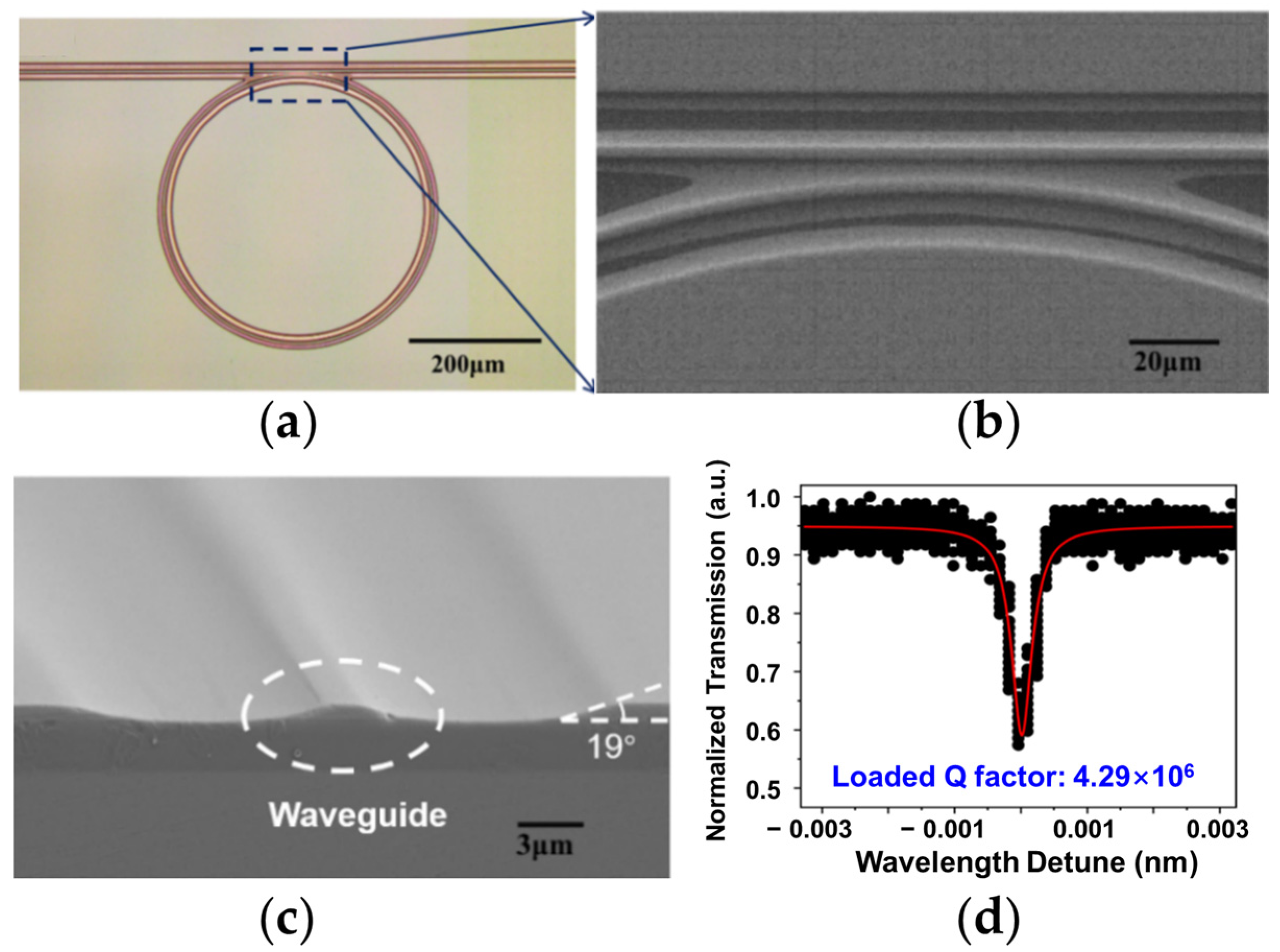
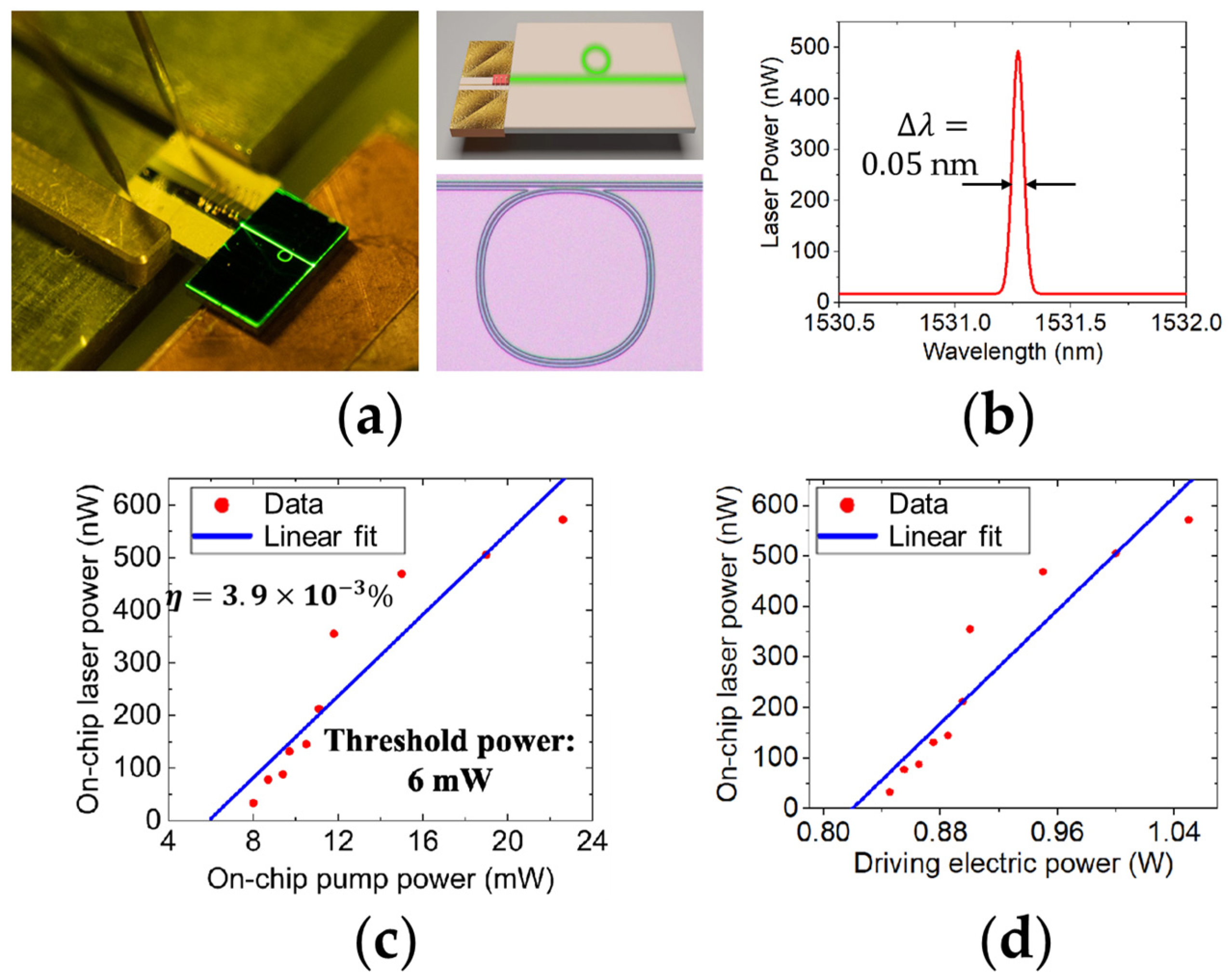
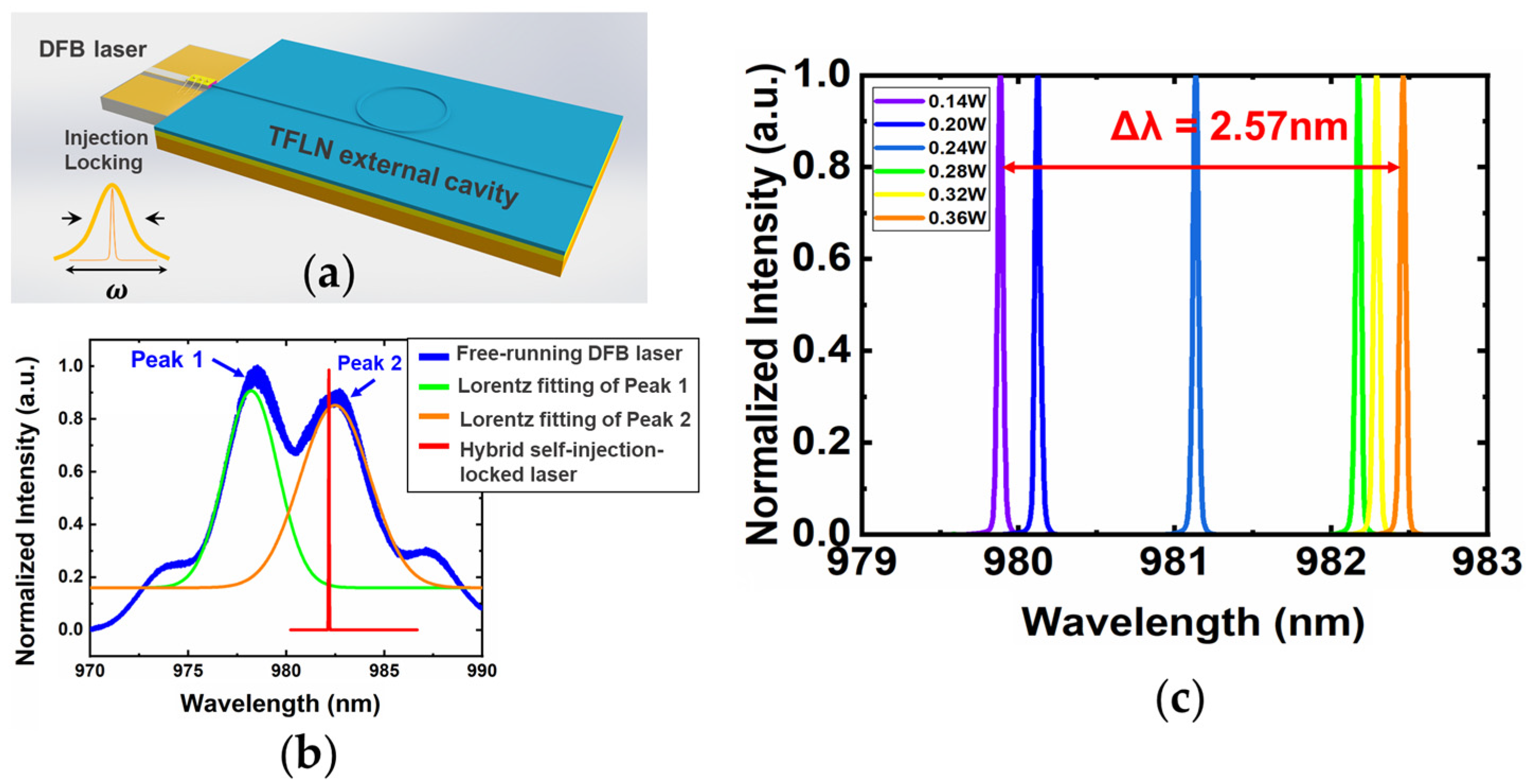
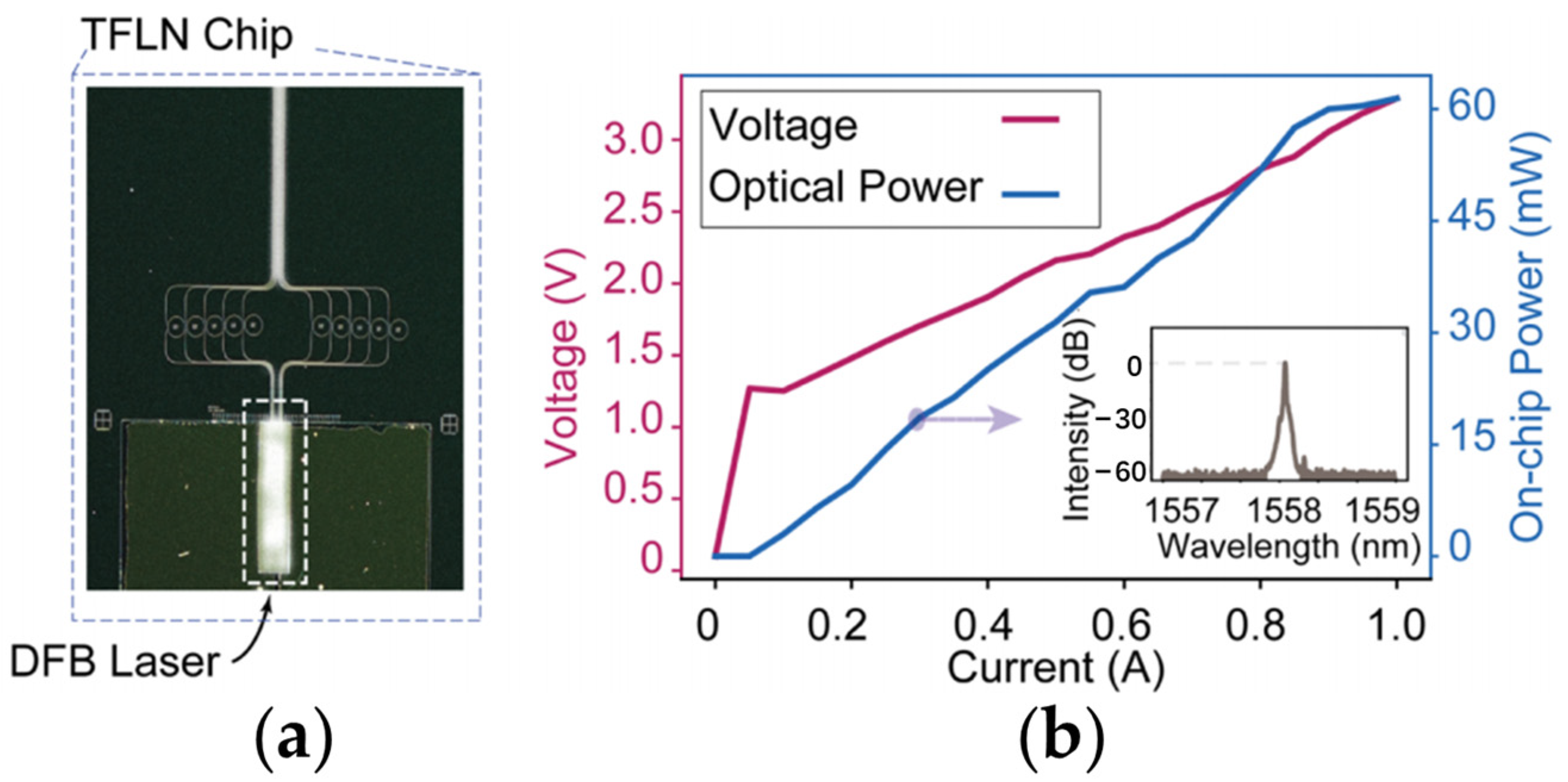

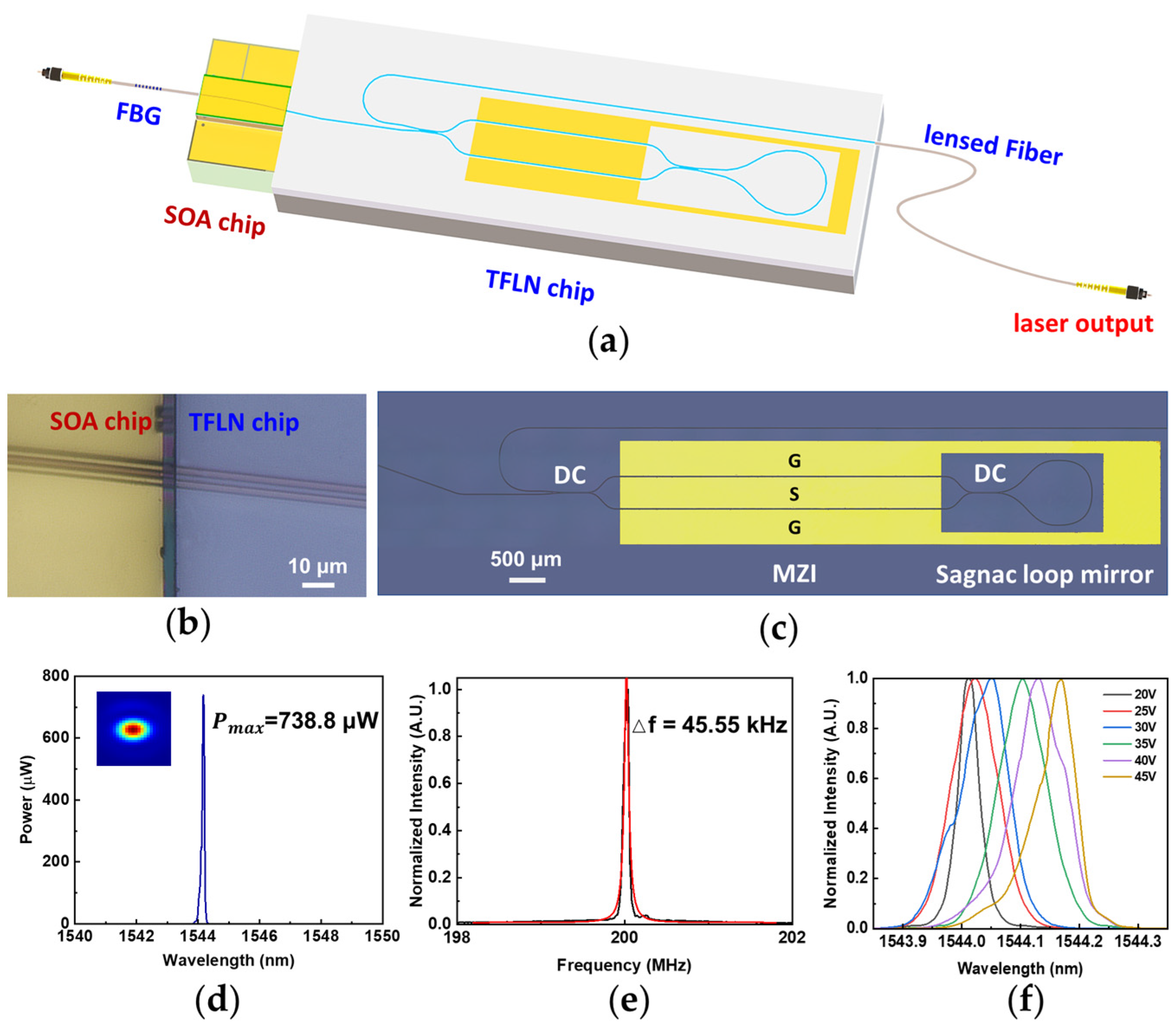
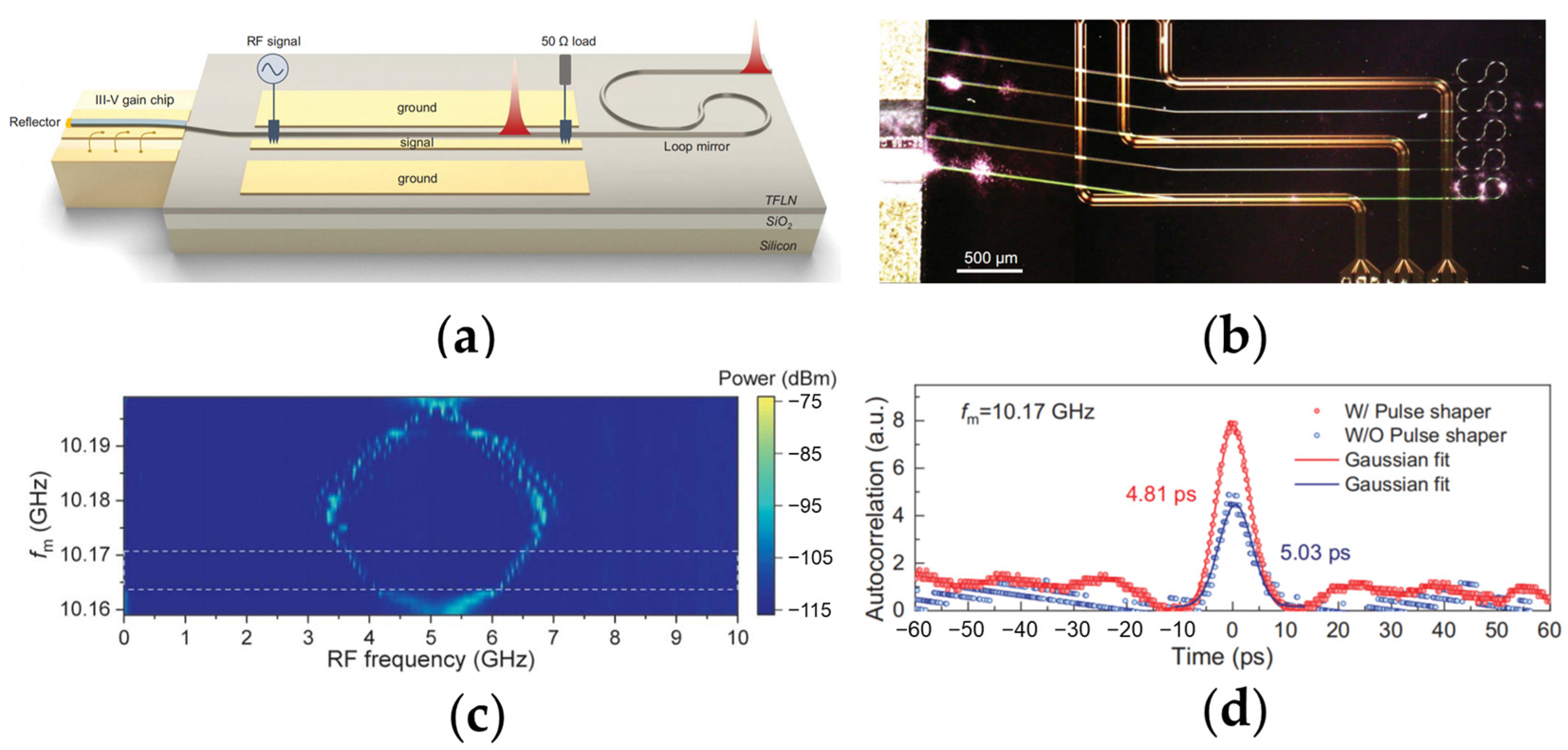




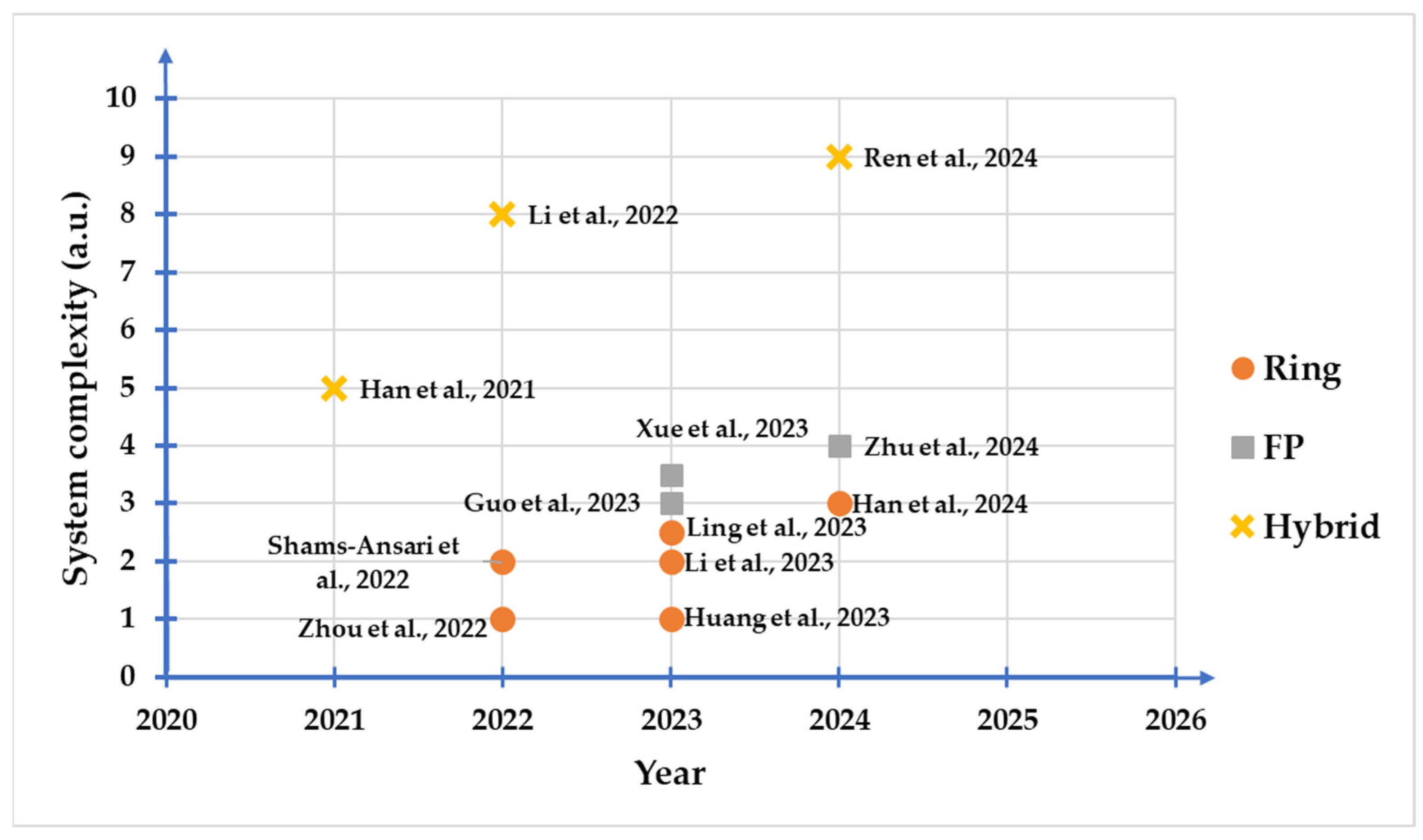
| Sample No. | Wavelength (nm) | Loaded Q (×106) |
|---|---|---|
| 1 | 1562.74 | 1.53 |
| 2 | 1566.53 | 1.87 |
| 3 | 1559.77 | 0.84 |
| 4 | 1553.87 | 1.39 |
| 5 | 1568.44 | 1.64 |
| 6 | 1556.05 | 1.15 |
| 7 | 1559.03 | 2.82 |
| 8 | 1549.55 | 2.92 |
| 9 | 1568.89 | 2.25 |
| 10 | 1555.90 | 3.27 |
| 11 | 1567.73 | 2.59 |
| 12 | 1553.50 | 3.06 |
| Main Structures of the TFLN Photonic Chip | Semiconductor Chip | Wavelength | Output Power | Linewidth | Coupling Loss | Tuning Range (Method) | SMSR | Ref. |
|---|---|---|---|---|---|---|---|---|
| Er3+ doped MRR | GaAs/AlGaAs DFB laser | 1531.27 nm | 500 nW | 0.05 nm | 10 dB | / | / | [111] |
| MRR | GaAs/AlGaAs DFB laser | 982 nm | 4.27 mW | 2 nm | 10 dB | 2.57 nm (DFB current) | / | [112] |
| MRR array | InP DFB laser | 1558 nm | 19.8 mW | <1 MHz | 10 dB | / | / | [87] |
| racetrack MRR | InP DFB laser | 1556 nm | ~0.4 mW | ~242 kHz | / | 760 MHz (EO) | 60 dB | [113] |
| PPLN racetrack MRR | InP DFB laser | 779.8 nm (SHG) | 2 mW (on-chip) | 4.7 kHz | / | / | / | [114] |
| PM + racetrack MRR | DFB laser | 1550 nm | 3.18 mW | 2.5 kHz | 6 dB | / | 60 dB | [115] |
| MZI + SLR | InP ROA | 1544 nm | 738.8 μW | 45.5 kHz | / | 0.16 nm, 20 GHz (EO) | / | [118] |
| PM + broadband LM | Single-angled facet (SAF) GaAs gain chip | 1065 nm | 50 mW (average) | 0.35 nm | 3.4–3.9 dB | / | / | [86] |
| PS + DBR | RSOA | 1516.21 nm | 2.1 mW | 94 kHz | / | 8 GHz (EO) | 50 dB | [119] |
| two cascaded MRRs + DBR | InP RSOA | 1331.88 nm | 2.5 mW | / | / | 36.4 nm (TO) | 60 dB | [122] |
| PS + 3 cascaded MRRs + LM | InP RSOA | 1614.3 nm | 0.98 mW | / | 1.87 dB | 96 nm (EO) | 52 dB | [124] |
| PS + 2 cascaded racetrack MRRs + LM | RSOA | 1581.12 nm | 5.5 mW (on-chip) | 11.3 kHz | 3–4 dB | 20 nm (TO); 1.2 GHz (EO) | 50 dB | [125] |
Disclaimer/Publisher’s Note: The statements, opinions and data contained in all publications are solely those of the individual author(s) and contributor(s) and not of MDPI and/or the editor(s). MDPI and/or the editor(s) disclaim responsibility for any injury to people or property resulting from any ideas, methods, instructions or products referred to in the content. |
© 2024 by the authors. Licensee MDPI, Basel, Switzerland. This article is an open access article distributed under the terms and conditions of the Creative Commons Attribution (CC BY) license (https://creativecommons.org/licenses/by/4.0/).
Share and Cite
Wang, M.; Fang, Z.; Zhang, H.; Lin, J.; Zhou, J.; Huang, T.; Zhu, Y.; Li, C.; Yu, S.; Fu, B.; et al. Recent Progresses on Hybrid Lithium Niobate External Cavity Semiconductor Lasers. Materials 2024, 17, 4453. https://doi.org/10.3390/ma17184453
Wang M, Fang Z, Zhang H, Lin J, Zhou J, Huang T, Zhu Y, Li C, Yu S, Fu B, et al. Recent Progresses on Hybrid Lithium Niobate External Cavity Semiconductor Lasers. Materials. 2024; 17(18):4453. https://doi.org/10.3390/ma17184453
Chicago/Turabian StyleWang, Min, Zhiwei Fang, Haisu Zhang, Jintian Lin, Junxia Zhou, Ting Huang, Yiran Zhu, Chuntao Li, Shupeng Yu, Botao Fu, and et al. 2024. "Recent Progresses on Hybrid Lithium Niobate External Cavity Semiconductor Lasers" Materials 17, no. 18: 4453. https://doi.org/10.3390/ma17184453
APA StyleWang, M., Fang, Z., Zhang, H., Lin, J., Zhou, J., Huang, T., Zhu, Y., Li, C., Yu, S., Fu, B., Qiao, L., & Cheng, Y. (2024). Recent Progresses on Hybrid Lithium Niobate External Cavity Semiconductor Lasers. Materials, 17(18), 4453. https://doi.org/10.3390/ma17184453








